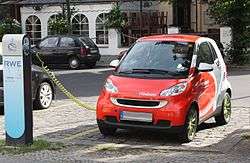Electric bicycle
An electric bicycle also known as an e-bike is a bicycle with an integrated electric motor which can be used for propulsion. Many kinds of e-bikes are available worldwide, from e-bikes that only have a small motor to assist the rider's pedal-power (i.e. pedelecs) to more powerful e-bikes which are closer to moped-style functionality. All retain the ability to be pedalled by the rider and are therefore not electric motorcycles.
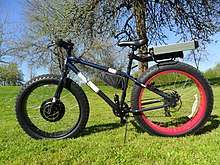
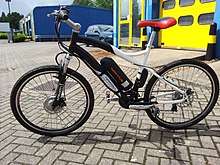
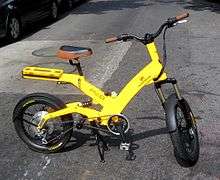

E-bikes use rechargeable batteries and the lighter ones can travel up to 25 to 32 km/h (16 to 20 mph), depending on local laws, while the more high-powered varieties can often do more than 45 km/h (28 mph). In some markets, such as Germany as of 2013, they are gaining in popularity and taking some market share away from conventional bicycles,[1] while in others, such as China as of 2010, they are replacing fossil fuel-powered mopeds and small motorcycles.[2][3]
Depending on local laws, many e-bikes (e.g., pedelecs) are legally classified as bicycles rather than mopeds or motorcycles. This exempts them from the more stringent laws regarding the certification and operation of more powerful two-wheelers which are often classed as electric motorcycles. E-bikes can also be defined separately and treated under distinct Electric bicycle laws.
E-bikes are the electric motor-powered versions of motorized bicycles, which have been in use since the late 19th century. Some bicycle-sharing systems use them.[4]
History
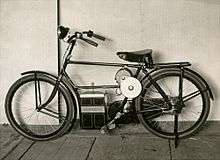
In the 1890s, electric bicycles were documented within various U.S. patents. For example, on 31 December 1895, Ogden Bolton Jr. was granted U.S. Patent 552,271 for a battery-powered bicycle with "6-pole brush-and-commutator direct current (DC) hub motor mounted in the rear wheel". There were no gears and the motor could draw up to 100 amperes (A) from a 10-volt battery.[5]
Two years later, in 1897, Hosea W. Libbey of Boston invented an electric bicycle (U.S. Patent 596,272) that was propelled by a "double electric motor". The motor was designed within the hub of the crankset axle.[6] This model was later re-invented and imitated in the late 1990s by Giant Lafree e-bikes.
By 1898 a rear-wheel drive electric bicycle, which used a driving belt along the outside edge of the wheel, was patented by Mathew J. Steffens. Also, the 1899 U.S. Patent 627,066 by John Schnepf depicted a rear-wheel friction “roller-wheel” style drive electric bicycle.[7] Schnepf's invention was later re-examined and expanded in 1969 by G.A. Wood Jr. with his U.S. Patent 3,431,994. Wood's device used 4 fractional horsepower motors; connected through a series of gears.[8]
Torque sensors and power controls were developed in the late 1990s. For example, Takada Yutky of Japan filed a patent in 1997 for such a device. In 1992 Vector Services Limited offered and sold an e-bike dubbed Zike.[9] The bicycle included NiCd batteries that were built into a frame member and included an 850 g permanent-magnet motor. Despite the Zike, in 1992 hardly any commercial e-bikes were available.
Yamaha, a Japanese automotive giant built one of the early prototypes of ebike back in 1989 and invented the pedal assist system in 1993.[10]
Production grew from 1993 to 2004 by an estimated 35%. By contrast, according to Gardner, in 1995 regular bicycle production decreased from its peak 107 million units.
American car icon, Lee Iacocca founded EV Global motors in 1997, a company that produced an electric bicycle model named E-bike SX and it was one of the early efforts to popularize ebikes in the United States.[11]
Some of the less expensive e-bikes used bulky lead acid batteries, whereas newer models generally used NiMH, NiCd, and/or Li-ion batteries, which offered lighter, denser capacity batteries. Performance varies; however, in general there is an increase in range and speed with the latter battery types.
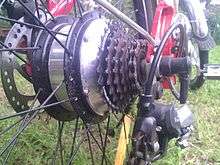
By 2001 the terms e-bike, power bike, "pedelec", pedal-assisted, and power-assisted bicycle were commonly used to refer to e-bikes. The terms "electric motorbike" or "e-motorbike" refer to more powerful models that attain up to 80 km/h (50 mph).
In a parallel hybrid motorized bicycle, such as the aforementioned 1897 invention by Hosea W. Libbey, human and motor inputs are mechanically coupled either in the bottom bracket, the rear wheel, or the front wheel, whereas in a (mechanical) series hybrid cycle, the human and motor inputs are coupled through differential gearing. In an (electronic) series hybrid cycle, human power is converted into electricity and is fed directly into the motor and mostly additional electricity is supplied from a battery.
By 2007 e-bikes were thought to make up 10 to 20 percent of all two-wheeled vehicles on the streets of many major Chinese cities.[12] A typical unit requires 8 hours to charge the battery, which provides the range of 25 to 30 miles (40 to 48 km),[12] at the speed of around 20 km/h.[13]

Classes

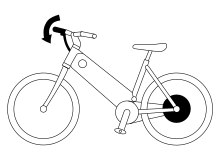
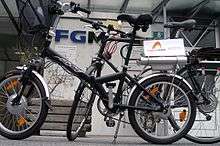
E-bikes are classed according to the power that their electric motor can deliver and the control system, i.e., when and how the power from the motor is applied. Also the classification of e-bikes is complicated as much of the definition is due to legal reasons of what constitutes a bicycle and what constitutes a moped or motorcycle. As such, the classification of these e-bikes varies greatly across countries and local jurisdictions.
Despite these legal complications, the classification of e-bikes is mainly decided by whether the e-bike's motor assists the rider using a pedal-assist system or by a power-on-demand one. Definitions of these are as follows:
- With pedal-assist the electric motor is regulated by pedalling. The pedal-assist augments the efforts of the rider when they are pedalling. These e-bikes – called pedelecs – have a sensor to detect the pedalling speed, the pedalling force, or both. Brake activation is sensed to disable the motor as well.
- With power-on-demand the motor is activated by a throttle, usually handlebar-mounted just like on most motorcycles or scooters.
Therefore, very broadly, e-bikes can be classed as:
- E-bikes with pedal-assist only: either pedelecs (legally classed as bicycles) or S-Pedelecs (often legally classed as mopeds)
- Pedelecs: have pedal-assist only, motor assists only up to a decent but not excessive speed (usually 25 km/h), motor power up to 250 watts, often legally classed as bicycles
- S-Pedelecs: have pedal-assist only, motor power can be greater than 250 watts, can attain a higher speed (e.g., 45 km/h) before motor stops assisting, legally classed as a moped or motorcycle (not a bicycle)
- E-bikes with power-on-demand and pedal-assist
- E-bikes with power-on-demand only: often have more powerful motors than pedelecs but not always, the more powerful of these are legally classed as mopeds or motorcycles
Pedal-assist only
E-bikes with pedal-assist only are usually called pedelecs but can be broadly classified into pedelecs proper and the more powerful S-Pedelecs.
Pedelecs
The term "pedelec" (from pedal electric cycle) refers to a pedal-assist e-bike with a relatively low-powered electric motor and a decent but not excessive top speed. Pedelecs are legally classed as bicycles rather than low-powered motorcycles or mopeds.
The most influential definition of pedelecs comes from the EU. EU directive (EN15194 standard) for motor vehicles considers a bicycle to be a pedelec if:
- the pedal-assist, i.e. the motorised assistance that only engages when the rider is pedalling, cuts out once 25 km/h is reached, and
- when the motor produces maximum continuous rated power of not more than 250 watts (n.b. the motor can produce more power for short periods, such as when the rider is struggling to get up a steep hill).
An e-bike conforming to these conditions is considered to be a pedelec in the EU and is legally classed as a bicycle. The EN15194 standard is valid across the whole of the EU and has also been adopted by some non-EU European nations and also some non-European jurisdictions (such as the state of Victoria in Australia).[14]
Pedelecs are much like conventional bicycles in use and function — the electric motor only provides assistance, for example, when the rider is climbing or struggling against a headwind. Pedelecs are therefore especially useful for people in hilly areas where riding a bike would prove too strenuous for many to consider taking up cycling as a daily means of transport. They are also useful for riders who more generally need some assistance, e.g. for people with heart, leg muscle or knee joint issues.
S-Pedelecs
More powerful pedelecs which are not legally classed as bicycles are dubbed S-Pedelecs (short for Schnell-Pedelecs, i.e. Speedy-Pedelecs) in Germany. These have a motor more powerful than 250 watts and less limited, or unlimited, pedal-assist, i.e. the motor does not stop assisting the rider once 25 km/h has been reached. S-Pedelec class e-bikes are therefore usually classified as mopeds or motorcycles rather than as bicycles and therefore may (depending on the jurisdiction) need to be registered and insured, the rider may need some sort of driver's license (either car or motorcycle) and motorcycle helmets may have to be worn.[15] In the United States, many states have adopted S-Pedelecs into the Class 3 category. Class 3 ebikes are limited to <=750 watts of power and 28 mph.[16]
Power-on-demand and pedal-assist
Some of the newer electric bikes include a pedal assist system (PAS) with or without throttle. This allows users to pedal alongside the electric motor to increase distance per charge. There are also electric bike conversion kits for turning non-electric bikes into e-bikes.
Power-on-demand only
Some e-bikes have an electric motor that operates on a power-on-demand basis only. In this case, the electric motor is engaged and operated manually using a throttle, which is usually on the handgrip just like the ones on a motorbike or scooter. These sorts of e-bikes often, but not always, have more powerful motors than pedelecs do.
With power-on-demand only e-bikes the rider can:
- ride by pedal power alone, i.e. fully human-powered.
- ride by electric motor alone by operating the throttle manually.
- ride using both together at the same time.
Some power-on-demand only e-bikes can hardly be confused with, let alone categorised as, bicycles. For example, the Noped is a term used by the Ministry of Transportation of Ontario for e-bikes which do not have pedals or in which the pedals have been removed from their motorised bicycle. These are better categorised as electric mopeds or electric motorcycles.
Legal status
| Country/jurisdiction | Type of e-bike | Speed limit, km/h | mph | Watt limit | Weight limit, kg | Age requirement | Demands license plates | Allowed on bike paths | References & footnotes |
|---|---|---|---|---|---|---|---|---|---|
| pedelec | 25 + 10% | 15.5 | 250 | None | None | No | Yes |
ACT[17] NSW[18] NT[19] QLD[20] SA[21] Tas[22] Vic [23] WA[24] | |
| hand-throttle | None | None | 200 | None | None | No | Yes |
ACT[17] NSW[18] NT[19] QLD[20] SA[21] Tas[22] Vic[23] WA[24] | |
| hand-throttle | 32 | 20 | 500 | None | Various | No | Varies from municipal by-laws | ||
| Unknown | 30 | 18.5 | None | 20 | None | No | Yes | (***) | |
and |
pedelec | 25 +10% | 15.5 | 250 | None | None | No | Yes | [25] |
| s-pedelec | 45 | 28 | 350 | None | 16 | Yes | No | ||
| speed pedelec | 45 | 28 | 500 | None | None | Yes | No(*) | [26] | |
| none allowed | – | – | – | – | – | – | – | [27] (**) | |
| pedelec | 25 | 15.5 | 250 | 30 | 16 | No | Yes | ||
| both | same as motorcycles | same as motorcycles | – | – | 15+[28] | Yes | No | [29] | |
| pedelec | None | None | 300 | None | None | No | Yes | ||
| both | 25 | 16 | None | 40 | None | No | Yes | [30] | |
| pedelec | 25 | 15.5 | 250 | None | None | No | Yes | [31] | |
| pedelec | 25 | 15.5 | 250 | 30 | 14 | No | Yes | [32][33] | |
| hand-throttle | 32 | 20 | 750 | None | None | No | Varies | (***) |
(*) Allowed on bike paths when electric systems are turned off (**) E-bikes are illegal in this region (***) Some regions have special regulations, see corresponding entry under Electric bicycle laws.
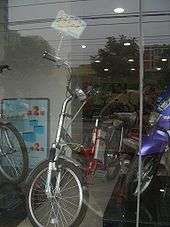
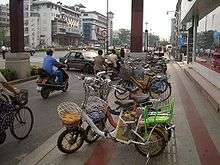

Popularity
E-bike usage worldwide has experienced rapid growth since 1998.[2][34]
China is the world's leading producer of e-bikes. According to the data of the China Bicycle Association, a government-chartered industry group, in 2004 China's manufacturers sold 7.5 million e-bikes nationwide, which was almost twice the year 2003 sales;[13] domestic sales reached 10 million in 2005, and 16 to 18 million in 2006.[12] In 2016, approximately 210 million electric bikes were used daily in China.[35]
A total of 700,000 e-bikes were sold in Europe in 2010, up from 200,000 in 2007 and 500,000 units in 2009.[36] Approximately 2 million were sold in Europe in 2016.[35] In 2019, the EU implemented a 79.3% protective tariff on imported Chinese e-bikes to protect EU producers.[37]
Technical
Motors and drivetrains
The two most common types of hub motors used in electric bicycles are brushed and brushless. Many configurations are available, varying in cost and complexity; direct-drive and geared motor units are both used. An electric power-assist system may be added to almost any pedal cycle using chain drive, belt drive, hub motors or friction drive. BLDC hub motors are a common modern design. The motor is built into the wheel hub itself, while the stator is fixed solidly to the axle, and the magnets are attached to and rotating with the wheel. The bicycle wheel hub is the motor. The power levels of motors used are influenced by available legal categories and are often, but not always limited to under 750 watts.
Another type of electric assist motor, often referred to as the mid-drive system, is increasing in popularity. With this system, the electric motor is not built into the wheel but is usually mounted near (often under) the bottom bracket shell. In more typical configurations, a cog or wheel on the motor drives a belt or chain that engages with a pulley or sprocket fixed to one of the arms of the bicycle's crankset. Thus the propulsion is provided at the pedals rather than at the wheel, being eventually applied to the wheel via the bicycle's standard drive train.
Because the power is applied through the chain and sprocket, power is typically limited to around 250–500 watts to protect against fast wear on the drivetrain. An electric mid-drive combined with an internal gear hub at the back hub may require care due to the lack of a clutch mechanism to soften the shock to the gears at the moment of re-engagement. A continuously variable transmission or a fully automatic internal gear hub may reduce the shocks due to the viscosity of oils used for liquid coupling instead of the mechanical couplings of the conventional internal gear hubs.
Batteries
E-bikes use rechargeable batteries, electric motors and some form of control. Battery systems in use include sealed lead-acid (SLA), nickel-cadmium (NiCad), nickel-metal hydride (NiMH) or lithium-ion polymer (Li-ion). Batteries vary according to the voltage, total charge capacity (amp hours), weight, the number of charging cycles before performance degrades, and ability to handle over-voltage charging conditions. The energy costs of operating e-bikes are small, but there can be considerable battery replacement costs. The lifespan of a battery pack varies depending on the type of usage. Shallow discharge/recharge cycles will help extend the overall battery life.
Range is a key consideration with e-bikes, and is affected by factors such as motor efficiency, battery capacity, efficiency of the driving electronics, aerodynamics, hills and weight of the bike and rider.[38][39] Some manufacturers, such as the Canadian BionX or American Vintage Electric Bikes,[40] have the option of using regenerative braking, the motor acts as a generator to slow the bike down prior to the brake pads engaging.[41] This is useful for extending the range and the life of brake pads and wheel rims. There are also experiments using fuel cells. e.g. the PHB. Some experiments have also been undertaken with super capacitors to supplement or replace batteries for cars and some SUVS. E-bikes developed in Switzerland in the late 1980s for the Tour de Sol solar vehicle race came with solar charging stations but these were later fixed on roofs and connected so as to feed into the electric mains.[42] The bicycles were then charged from the mains, as is common today. While ebike batteries were produced mainly by bigger companies in past, many small to medium companies have started using innovative new methods for creating more durable batteries. State of the art, custom built automated precision CNC spot welding machines[43] created 18650 battery packs[44] are commonly used among Do-it-yourself ebike makers.
Controllers
There are two distinct types of controllers designed to match either a brushed motor or brushless motor. Brushless motors are becoming more common as the cost of controllers continues to decrease. (See the page on DC motors which covers the differences between these two types.)
Controllers for brushless motors: E-bikes require high initial torque and therefore models that use brushless motors typically have Hall sensor commutation for speed and angle measurement. An electronic controller provides assistance as a function of the sensor inputs, the vehicle speed and the required force. The controllers generally allow input by means of potentiometer or Hall Effect twist grip (or thumb-operated lever throttle), closed-loop speed control for precise speed regulation, protection logic for over-voltage, over-current and thermal protection. Bikes with a pedal assist function typically have a disc on the crank shaft featuring a ring of magnets coupled with a Hall sensor giving rise to a series of pulses, the frequency of which is proportional to pedaling speed. The controller uses pulse width modulation to regulate the power to the motor. Sometimes support is provided for regenerative braking but infrequent braking and the low mass of bicycles limits recovered energy. An implementation is described in an application note for a 200 W, 24 V Brushless DC (BLDC) motor.[45]
Controllers for brushed motors: Brushed motors are also used in e-bikes but are becoming less common due to their intrinsic lower efficiency. Controllers for brushed motors however are much simpler and cheaper due to the fact they do not require hall sensor feedback and are typically designed to be open-loop controllers. Some controllers can handle multiple voltages.
Design variations
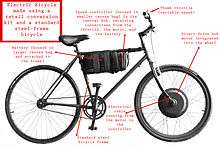

Not all e-bikes take the form of conventional push-bikes with an incorporated motor, such as the Cytronex bicycles which use a small battery disguised as a water bottle.[46][47] Some are designed to take the appearance of low capacity motorcycles, but smaller in size and consisting of an electric motor rather than a petrol engine. For example, the Sakura e-bike incorporates a 200 W motor found on standard e-bikes, but also includes plastic cladding, front and rear lights, and a speedometer. It is styled as a modern moped, and is often mistaken for one.
Converting a non-electric bicycle to its electric equivalent can be complicated but numerous 'replace a wheel' solutions are now available on the market.[48]
An Electric Pusher Trailer is an e-bike design which incorporates a motor and battery into a trailer that pushes any bicycle. One such trailer is the two-wheeled Ridekick. Other, rarer designs include that of a 'chopper' styled e-bike, which are designed as more of a 'fun' or 'novelty' e-bike than as a purposeful mobility aid or mode of transport.
Electric cargo bikes allow the rider to carry large, heavy items which would be difficult to transport without electric power supplementing the human power input.[49]
There are many e-bikes design variations available, some with batteries attached to the frame, some housed within the tube.
Various designs (including those mentioned above) are designed to fit inside most area laws, and the ones that contain pedals can be used on roads in the United Kingdom, among other countries.
Folding e-bikes are also available.[50]
Electric self-balancing unicycles do not conform to e-bike legislation in most countries and therefore cannot be used on the road,[51] but can be utilized in the sidewalk. They are the cheapest electric cycles and used by the last mile commuters, for urban use and to be combined with public transport, including buses.
Tricycles
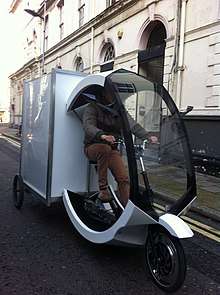
Electric trikes have also been produced that conform to the e-bike legislation. These have the benefit of additional low speed stability and are often favored by people with disabilities. Cargo carrying tricycles are also gaining acceptance, with a small but growing number of couriers using them for package deliveries in city centres.[52][53] Latest designs of these trikes resemble a cross-between a pedal cycle and a small van.[54][55]
While some people like the added stability offered by tricycles as compared to bikes, the things can actually be tippier when cornering.
Health effects
E-bike use was shown to increase the amount of physical activity. E-bike users in 7 European cities had 10% higher weekly energy expenditure than other cyclists because they cycled longer trips.[56]
E-bikes can also provide a source of exercise for individuals who have trouble exercising for an extended time (due to injury or excessive weight, for example) as the bike can allow the rider to take short breaks from pedaling and also provide confidence to the rider that they'll be able to complete the selected path without becoming too fatigued[57] or without having forced their knee joints too hard (people who need to use their knee joints without wearing them out unnecessarily may in some electric bikes adjust the level of motor assistance according to the terrain). A University of Tennessee study provides evidence that energy expenditure (EE) and oxygen consumption (VO2) for e-bikes are 24% lower than that for conventional bicycles, and 64% lower than for walking. Further, the study notes that the difference between e-bikes and bicycles are most pronounced on the uphill segments.[58]
There are individuals who claim to have lost considerable amounts of weight by using an electric bike.[59] A recent prospective cohort study however found that people using e-bikes have a higher BMI than those using conventional bikes.[60] By making the biking terrain less of an issue, people who would not otherwise consider biking can use the electric assistance when needed and otherwise pedal as they are able.[61] E-bikes can be a useful part of cardiac rehabilitation programmes, since health professionals will often recommend a stationary bike be used in the early stages of these. Exercise-based cardiac rehabilitation programmes can reduce deaths in people with coronary heart disease by around 27%.[62]
Road traffic safety
China's experience, as the leading e-bike world market, has raised concerns about road traffic safety and several cities have considered banning them from bicycle lanes.[2] As the number of e-bikes increased and more powerful motors are used, capable of reaching up to 30 miles per hour (48 km/h), the number of traffic accidents have risen significantly in China. E-bike riders are more likely than a car driver to be killed or injured in a collision, and because e-bikers use conventional bicycle lanes they mix with slower-moving bicycles and pedestrians, increasing the risk of traffic collisions.[2]
Environmental effects
E-bikes are zero-emissions vehicles, as they emit no combustion by-products. However, the environmental effects of electricity generation and power distribution and of manufacturing and disposing of (limited life) high storage density batteries must be taken into account. Even with these issues considered, e-bikes are claimed to have a significantly lower environmental impact than conventional automobiles, and are generally seen as environmentally desirable in an urban environment.[63]
The environmental effects involved in recharging the batteries can of course be reduced. The small size of the battery pack on an e-bike, relative to the larger pack used in an electric car, makes them very good candidates for charging via solar power or other renewable energy resources. Sanyo capitalized on this benefit when it set up "solar parking lots", in which e-bike riders can charge their vehicles while parked under photovoltaic panels.[64]
The environmental credentials of e-bikes, and electric / human powered hybrids generally, have led some municipal authorities to use them, such as Little Rock, Arkansas with their Wavecrest electric power-assisted bicycles or Cloverdale, California police with Zap e-bikes. China's e-bike manufacturers, such as Xinri, are now partnering with universities in a bid to improve their technology in line with international environmental standards, backed by the Chinese government who is keen to improve the export potential of the Chinese manufactured e-bikes.[65]
Both land management regulators and mountain bike trail access advocates have argued for bans of electric bicycles on outdoor trails that are accessible to mountain bikes, citing potential safety hazards as well as the potential for electric bikes to damage trails. A study conducted by the International Mountain Bicycling Association, however, found that the physical impacts of low-powered pedal-assist electric mountain bikes may be similar to traditional mountain bikes.[66]
A recent study on the environment impact of e-bikes vs other forms of transportation[67] found that e-bikes are:
- 18 times more energy efficient than an SUV
- 13 times more energy efficient than a sedan
- 6 times more energy efficient than rail transit
- and, of about equal impact to the environment as a conventional bicycle.
One major concern is disposal of used lead batteries, which can cause environmental contamination if not recycled.[2]
There are strict shipping regulations for lithium-ion batteries, due to safety concerns.[68] In this regard, lithium iron phosphate batteries are safer than lithium cobalt oxide batteries.[69]
Experience by country

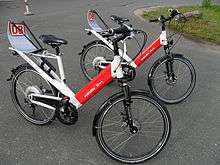
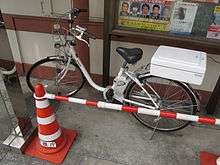
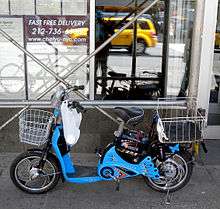
China
China has experienced an explosive growth of sales of non-assisted e-bikes including scooter type, with annual sales jumping from 56,000 units in 1998 to over 21 million in 2008,[70] and reaching an estimated fleet of 120 million e-bikes in early 2010.[2][71] This boom was triggered by Chinese local governments' efforts to restrict motorcycles in city centers to avoid traffic disruption and accidents. By late 2009 motorcycles are banned or restricted in over ninety major Chinese cities.[70] Users began replacing traditional bicycles and motorcycles and e-bike became an alternative to commuting by car.[2] Nevertheless, road safety concerns continue as around 2,500 e-bike related deaths were registered in 2007.[71] By late 2009 ten cities had also banned or imposed restrictions on e-bikes on the same grounds as motorcycles. Among these cities were Guangzhou, Shenzhen, Changsha, Foshan, Changzhou, and Dongguang.[70][71]
China is the world's leading manufacturer of e-bikes, with 22.2 million units produced in 2009. Some of the biggest manufacturers of E-bikes in the world are BYD and Geoby. Production is concentrated in five regions, Tianjin, Zhejiang, Jiangsu, Shandong, and Shanghai.[72] China exported 370,000 e-bikes in 2009.[73]
India
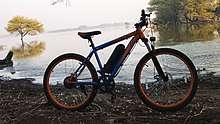
The first pedal-assisted bicycles appeared in India in 1993. In 2008, the sales of e-bike sales exceeded moped sales. In recent years, 2-passenger and even 3-passenger (two adults and a child) e-bikes were introduced in India.[74][75]
Netherlands
The Netherlands has a fleet of 18 million bicycles.[76] E-bikes have reached a market share of 10% by 2009, as e-bikes sales quadrupled from 40,000 units to 153,000 between 2006 and 2009,[77] and the electric-powered models represented 25% of the total bicycle sales revenue in that year.[76] By early 2010 one in every eight bicycles sold in the country is electric-powered despite the fact that on average an e-bike is three times more expensive than a regular bicycle.[71][77]
A 2008 market survey showed that the average distance traveled in the Netherlands by commuters on a standard bicycle is 6.3 kilometres (3.9 mi) while with an e-bike this distance increases to 9.8 kilometres (6.1 mi).[78] This survey also showed that e-bike ownership is particularly popular among people aged 65 and over, but limited among commuters. The e-bike is used in particular for recreational bicycle trips, shopping and errands.[78]
United States
In 2009 the U.S. had an estimated fleet of 200,000 e-bikes.[73] In 2012 they were increasingly favored in New York as food delivery vehicles.[79]
In 2012, two e-bike advocates completed the first 4,000-mile (6,400 km) transcontinental e-bike tour from New York to San Francisco to advocate for e-bikes in major cities across the U.S.[80] Pedego Electric Bikes is the best selling brand in the U.S. Many e-bikes in the United States are standard bicycles converted using a kit. In general, the kits include the motor (the majority of which are hub motors built into the front or rear wheel), a speed controller, throttle (usually twist-grip or thumb throttle), necessary wiring and connectors, and a battery. Several U.S. companies offer conversion kits which also offer advanced lithium battery packs. Major manufacturers also offer complete e-bikes. Trek offers a line of e-bikes using the Bionx system in which the rider programs the controller to determine how much effort the motor will give in response to rider effort, from 25% up to 200% of the rider's power. This system ensures a minimum level of rider participation and is also used to comply with many European laws mandating partial human effort before the motor engages.
Japan
In 2017, the first e-BIKE "XM-1" in Japan was released in market by Panasonic. And "YPJ-R" was also released in same month by YAMAHA.
From 2018, some e-BIKE tours were released. Shimanami Kaido, Izu Peninsula and Kyoto prefecture is eager to spread e-BIKE tourism.
See also
References
- "Electric Bikes Now Constitute 10 Percent of German Market". EVworld.com. Archived from the original on 10 September 2013. Retrieved 3 April 2013.
- J. David Goodman (2010-01-31). "An Electric Boost for Bicyclists". The New York Times. Retrieved 2010-05-31.
- Kathy Chu (2010-02-12). "Electric bikes face long road in U.S." USA Today. Retrieved 2010-05-31.
- "It's not a bike, it's a bike-shaped Uber that says "JUMP"". Retrieved 2017-11-10.
- "Electrical bicycle". Retrieved Apr 9, 2020.
- "Electric bicycle". Retrieved Apr 9, 2020.
- "schnepf". Retrieved Apr 9, 2020.
- "Electric drive for bicycles". Retrieved Apr 9, 2020.
- "Electric Bikes – Zike Bike Spares & Sales". Zikebike.com. Archived from the original on 2009-04-24. Retrieved 2009-08-31.
- "Best e Bike | Yamaha e Bikes".
- Tergesen, Anne (1997-09-21). "INVESTING IT; A Bet on Electric Bikes, or at Least on Lee Iacocca". The New York Times.
- "Cheap and green, electric bikes are the rage in China" Archived 2013-01-12 at Archive.today, by Tim Johnson. Originally published 23 May 2007 by McClatchy Newspapers.
- "China's Cyclists Take Charge", By Peter Fairley. IEEE Spectrum, June 2005
- "Power assisted bicycles". VicRoads website. VicRoads. Archived from the original on 28 March 2013. Retrieved 25 August 2013.
- "Was Sie über den Versicherungsschutz von pedelecs wissen sollten" (in German). Gesamtverband der Deutschen Versicherungswirtschaft (German Insurance Association). Retrieved 21 March 2013.
- "What Are Electric Bike Classes and Why do They Matter?".
- "Australian Capital Territory Government Road Transport (General) Amendment Act 2013" (PDF). Retrieved 26 November 2016.
- "New South Wales Government Roads and Maritime Services Vehicle standards information: Mopeds and power-assisted pedal cycles" (PDF). 8 December 2014. Retrieved 26 November 2016.
- "Northern Territory Government Department of Transport: V56 – Motorised Foot Scooters and Power-assisted Cycles" (PDF). 20 November 2015. Retrieved 26 November 2016.
- "Queensland Government: Bicycle road rules and safety". Retrieved 26 November 2016.
- "Government of South Australia: Riding a power-assisted bicycle". Retrieved 26 November 2016.
- "Tasmanian Government Information Sheet: Power-assisted Pedal Cycles". November 2016. Retrieved 26 November 2016.
- "Vicroads: Power assisted bicycles". Retrieved 26 November 2016.
- "Government of Western Australia: Bicycle rules, standards and safety". Retrieved 26 November 2016.
- European standard NF EN 15194 for Electrically power assisted cycles Archived 2012-12-24 at the Wayback Machine section 4.2.6.1 Requirements: The maximum [assisted] speed [is] 25 km/h (…) During a production conformity check, the maximum speed may differ by ± 10% from the above-mentioned determined value.
- Article on speed pedelec in Norway (in Norwegian)
- "Transport Department, Hong Kong SAR Government" (PDF). Retrieved Apr 9, 2020.
- "Permiso de conducir para menores de edad" (in Spanish). Archived from the original on 2015-12-22.
- "Reglamento de tránsito de la Ciudad de México" (PDF) (in Spanish). Archived from the original (PDF) on 2015-11-24.
- "電動輔助自行車及電動自行車介紹與法規修訂說明" (PDF). Retrieved Apr 16, 2020.
- "Bi̇si̇klet Yolları Yönetmeli̇ği̇" [Bicycle path regulations]. Official Gazette. 12 December 2019.
- "Electric bikes: licensing, tax and insurance". GOV.UK. Retrieved Apr 9, 2020.
- Rear, Jack; Davies, Paul; Morrissy-Swan, Tomé; Cooper, Jonny; Howell, Madeleine (2020-05-28). "The best e-bikes to get around on after lockdown: tried and tested". The Telegraph. ISSN 0307-1235. Retrieved 2020-05-29.
- M. Platter (2011-03-17). "Die Schweizer fahren immer mehr E-Bike". NZZ. Retrieved 2011-06-08.
- Black, Forbes. "The State of the Electric Bicycle Market", Electricbikereport.com, September 19, 2016
- "Europe's E-Bike Imports Indicate Market Size". Bike Europe. 2013-08-05. Retrieved 2013-10-25.
- "European Commission imposes up to 79.3% combined anti-dumping and anti-subsidy duties on e-bike imports from China". Jan 18, 2019. Retrieved Apr 9, 2020.
- "Electric bike trip simulator". Retrieved 2013-05-25.
- "Electric Bicycle Range"; Electric Bicycle Guide (retrieved 2014-03-09)
- "The Fastest Electric Bike | Vintage Electric Bikes".
- "BionX FAQ Page". Archived from the original on 2010-03-22. Retrieved 2010-03-19.
- Technisches "Reglement der Tour de Sol 1989/1990", published by Tour de Sol, Bern, Switzerland
- "EM3EV battery factory tour - State of the art 18650 battery packs". YouTube. 2017-06-09. Retrieved 2020-04-09.
- "EBike battery, motors and Electric Bike kits | EM3ev".
- Zilog, Inc (2008). "Electric Bike BLDC Hub Motor Control" (PDF). Zilog, Inc. Archived from the original (PDF) on 2011-07-18. Retrieved 2010-11-06.
- Henshaw, Peter (2008-09-05). "Cytronex Trek FX: A bike with boost". The Telegraph.
- Peace, Richard (2008-08-26). "Electric bikes start to come of age". Future Publishing.
- "Tron-inspired electric bike wheel chucks the hub". www.gizmag.com. 2 May 2016. Retrieved 2016-06-02.
- "Electric Cargo Bike Guide". Electric Bike Report. 2010-09-01. Retrieved 2010-10-06.
- Sutton, Mark (January 6, 2012). "EBCO introduces Solex electric bikes to the UK". Bike Biz. Retrieved 10 January 2012.
- Electric Unicycle by Amanda Kooser, May 18, 2011, cnet.com
- "Bubble Post". Retrieved Apr 9, 2020.
- "Gnewt | London's largest fully electric delivery fleet". Gnewt | London's largest fully electric delivery fleet. Retrieved Apr 9, 2020.
- http://ww1.cargo-trike.com/. Retrieved Apr 9, 2020. Missing or empty
|title=(help) - "Electric Delivery Trikes – will they catch on in Britain?". ITV Central News. 2013-11-20.
- Castro, A (2019). "Physical activity of electric bicycle users compared to conventional bicycle users and non-cyclists: Insights based on health and transport data from an online survey in seven European cities". Transportation Research Interdisciplinary Perspectives. 1: 100017. doi:10.1016/j.trip.2019.100017.
- "Why You Need an Electric Bike". MensFitness.com. 19 July 2013. Retrieved 2015-12-15.
- Langford, Brian Casey (2017). "Comparing physical activity of pedal-assist electric bikes with walking and conventional bicycles" (PDF).
- "Woman's Dramatic 280-pound Weight Loss". 2014-12-03. Retrieved 2015-12-15.
- Dons, E (2018). "Transport mode choice and body mass index: Cross-sectional and longitudinal evidence from a European-wide study" (PDF). Environment International. 119 (119): 109–116. doi:10.1016/j.envint.2018.06.023. hdl:10044/1/61061. PMID 29957352.
- "Pedego Electric Bike Makes Exercise Look and Feel Easy". 2015-04-11. Retrieved 2015-12-15.
- "Exercise – Rehabilitation – NHS Choices". Nhs.uk. 2010-01-25. Retrieved 2010-10-06.
- Fishman, Elliot; Cherry, Christopher (30 Jul 2015). "E-bikes in the Mainstream: Reviewing a Decade of Research". Transport Reviews. Taylor & Francis Online. 36 (1): 72–91. doi:10.1080/01441647.2015.1069907.
- Eaton, Kit (March 16, 2010). "Sanyo's Solar Bike Sheds—Green Power, Healthy and Clever". Fast Company. Retrieved 2010-03-19.
- "Electric Bicycles; the Green Innovation gaining traction in world export markets". Articlesbase.com. Retrieved 2010-10-06.
- Newland, Cameron (September 24, 2015). "IMBA Preliminary Study Results Suggest That Electric Bikes Aren't Especially Damaging To Mountain Bike Trails". Overvolted Electric Bike News and Reviews. Retrieved 2015-09-25.
- Shreya, Dave (February 2010). "Life Cycle Assessment of Transportation Options for Commuters" (PDF). Massachusetts Institute of Technology. Archived from the original (PDF) on 2011-07-15.
- "Information on Batteries in Transport". Retrieved Apr 9, 2020.
- Mitch Jacoby. "Assessing The Safety Of Lithium-Ion Batteries".
- Chi-Jen Yang (2010). "Launching strategy for electric vehicles: Lessons from China and Taiwan" (PDF). Technological Forecasting and Social Change (77): 831–834. Archived from the original (PDF) on 2010-03-31.
- "China's electric-bicycle boom – Pedals of fire". The Economist. 2010-05-13. Retrieved 2010-05-31.
- "China Remains World's Leading Electric Bicycle Manufacturer". EV World. 2005-05-28. Archived from the original on 2010-06-14. Retrieved 2010-06-01.
- "China switches to e-bikes". Asia Times. 2010-05-07. Retrieved 2010-06-01.
- "Electric bicycle market is enjoying the smooth growth". Energy Korea. 23 April 2012. Retrieved 3 April 2013.
- "Swagtron electric bikes and electric bicycle in India now". Swagtron India. Retrieved 2020-07-17.
- "Netherlands bicycle capital of the world". Dutch Daily News. 2010-01-26. Retrieved 2010-05-31.
- "In Holland One out of Eight Bikes Is Electric". Bike Europe. 2010-04-18. Retrieved 26 November 2016.
- Hendriksen, Ingrid; et al. (2008). "Electric bicycles – market research and investigation". Fiets Beraad. Retrieved 2010-05-31.
- Food deliverymen on wheels By J. DAVID GOODMAN, The New York Times, March 2, 2012
- "TriplePundit.com". 2012-04-17. Retrieved 2012-04-17.
External links
| Wikimedia Commons has media related to Electrically powered bicycles. |
